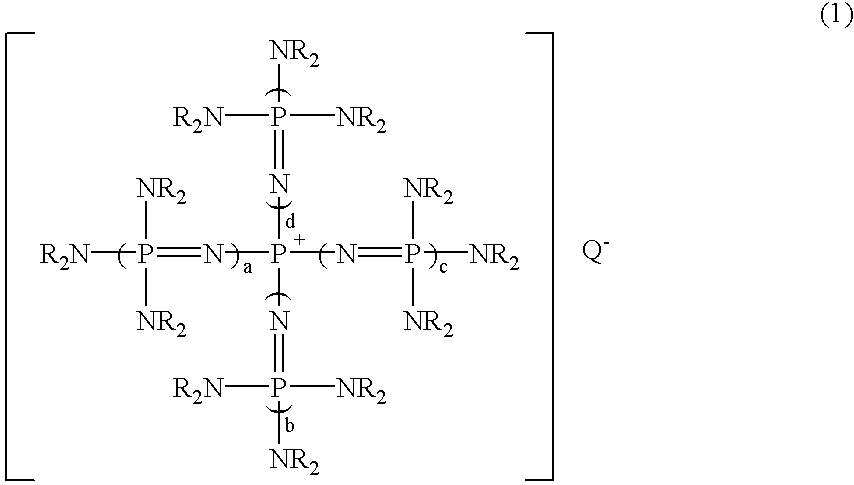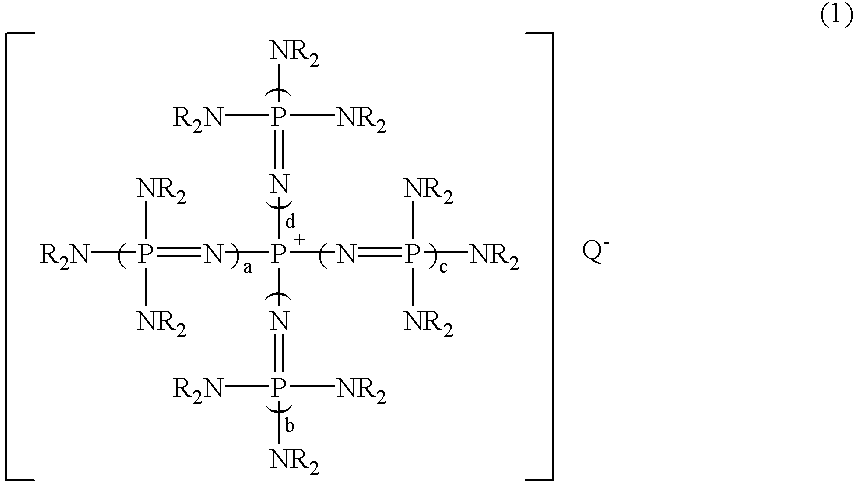Process for preparation of substituted aromatic compound
a technology of aromatic compound and process, which is applied in the field of process for the preparation of substituted aromatic compound, can solve the problems of low reactivity of chlorinated aromatic compound and lack of effective reaction agent or catalyst, and achieve the effect of high yield, effective nucleophilic substitution reaction, and effective method for producing substituted aromatic compound
- Summary
- Abstract
- Description
- Claims
- Application Information
AI Technical Summary
Benefits of technology
Problems solved by technology
Method used
Image
Examples
example 1
After 7.71 g (10.0 mmol) of a phosphazenium compound, tetrakis[tris(dimethylamino)phosphoranylideneamino]phosphonium methoxide: [(Me.sub.2 N).sub.3 P.dbd.N].sub.4 P.sup.+, MeO.sup.- was weighed into a 100 ml flask equipped with a thermometer under nitrogen atmosphere, 20.0 g (178 mmol) of chlorobenzene was added at room temperature. After the mixture was reacted at room temperature for 2 hours, a small volume of sample was taken from this reaction mixture and analyzed by gas chromatography. As a result, surprisingly in addition to the peak of chlorobenzene, a new peak was observed, which has a considerable integrated intensity. When GC-Mass (a mass spectrometry analyzer with gas chromatography) analysis of this reaction mixture was carried out, a molecular ion peak indicating methoxybenzene and a fragment ion peak indicating a phenyl group after the elimination of a methoxy group were detected at 108 and 77, respectively. This result shows that this new peak is methoxybenzene.
Again,...
example 2
After 7.59 g (10.0 mmol) of a phosphazenium compound, tetrakis[tris(dimethylamino)phosphoranylideneamino]phosphonium fluoride: [(Me.sub.2 N).sub.3 P.dbd.N].sub.4 P.sup.+, F.sup.- was weighed into a pressure glass vessel having a volume of 100 ml and equipped with a thermometer under nitrogen atmosphere, 20.0 g (178 mmol) of chlorobenzene was added at room temperature and the vessel was sealed. This solution was heated to 130.degree. C. and reacted at the temperature for 2 hours. After that, a small volume of sample was taken from the obtained reaction mixture and was quantitatively analyzed by gas chromatography similarly to Example 1. As a result, it was found that objective fluorobenzene was produced in the yield of 81%.
example 3
The reaction was carried out in the same manner as in Example 1, except that the same molar amount of tetrakis[tris (dimethylamino)phosphoranylideneamino]phosphonium tert-butylthiolate: [(Me.sub.2 N).sub.3 P.dbd.N].sub.4 P.sup.+, t-BuS.sup.- was used instead of tetrakis[tris(dimethylamino)phosphoranylideneamino]phosphonium methoxide in Example 1. Then, the quantitative analysis was carried out by similar gas chromatography. As a result, it was found that objective tert-butylphenyl thioether was produced in the yield of 99%.
PUM
| Property | Measurement | Unit |
|---|---|---|
| temperature | aaaaa | aaaaa |
| temperature | aaaaa | aaaaa |
| temperature | aaaaa | aaaaa |
Abstract
Description
Claims
Application Information
 Login to View More
Login to View More - R&D
- Intellectual Property
- Life Sciences
- Materials
- Tech Scout
- Unparalleled Data Quality
- Higher Quality Content
- 60% Fewer Hallucinations
Browse by: Latest US Patents, China's latest patents, Technical Efficacy Thesaurus, Application Domain, Technology Topic, Popular Technical Reports.
© 2025 PatSnap. All rights reserved.Legal|Privacy policy|Modern Slavery Act Transparency Statement|Sitemap|About US| Contact US: help@patsnap.com



